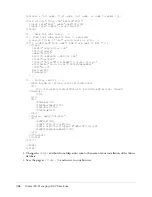
488
Chapter 23: Managing LDAP Directories
This search shows the use of a logical AND statement in a filter. It returns one attribute, the
surname, that is used only for sorting the results.
In this query, the
ou
attribute value consists of two values in a comma-delimited list. One is the
department name. The other is People. This is because the Airius database uses the ou attribute
type twice:
•
In the distinguished names, at the second level of the directory tree, where it differentiates
between organizational units such as people, groups, and directory servers
•
As the department identifier in each person’s entry
Because the attribute values are returned in order from the person entry to the directory tree root,
the
ListFirst
function extracts the person’s department name.
Updating an LDAP directory
The
cfldap
tag lets you do the following to LDAP directory entries:
•
Add
•
Delete
•
Add attributes
•
Delete attributes
•
Replace attributes
•
Change the DN (rename the entry)
These actions let you manage LDAP directory contents remotely.
The following sections show how to build a ColdFusion page that lets you manage an LDAP
directory:
•
“Adding a directory entry” on page 489
•
“Deleting a directory entry” on page 493
•
“Updating a directory entry” on page 495
The form displays directory entries in a table and includes a button that lets you populate the
form fields based on the unique user ID.
The example ColdFusion page does not add or delete entry attributes or change the DN. The
sections
“Adding and deleting attributes of a directory entry” on page 496
and
“Changing a
directory entry’s DN” on page 497
describe these operations.
To keep the code short, this example has limitations that are not appropriate in a production
application. In particular, it has the following limitations:
•
If you enter an invalid user ID and click either the Update or the Delete button, ColdFusion
generates a “No such object” error, because there is no directory entry to update or delete. Your
application should verify that the ID exists in the directory before it tries to change or delete its
entry.
•
If you enter a valid user ID in an empty form and click Update, the application deletes all the
attributes for the User. The application should ensure that all required attribute fields contain
valid entries before updating the directory.
Summary of Contents for ColdFusion MX
Page 1: ...Developing ColdFusion MX Applications...
Page 22: ...22 Contents...
Page 38: ......
Page 52: ...52 Chapter 2 Elements of CFML...
Page 162: ......
Page 218: ...218 Chapter 10 Writing and Calling User Defined Functions...
Page 250: ...250 Chapter 11 Building and Using ColdFusion Components...
Page 264: ...264 Chapter 12 Building Custom CFXAPI Tags...
Page 266: ......
Page 314: ...314 Chapter 14 Handling Errors...
Page 344: ...344 Chapter 15 Using Persistent Data and Locking...
Page 349: ...About user security 349...
Page 357: ...Security scenarios 357...
Page 370: ...370 Chapter 16 Securing Applications...
Page 388: ...388 Chapter 17 Developing Globalized Applications...
Page 408: ...408 Chapter 18 Debugging and Troubleshooting Applications...
Page 410: ......
Page 426: ...426 Chapter 19 Introduction to Databases and SQL...
Page 476: ...476 Chapter 22 Using Query of Queries...
Page 534: ...534 Chapter 24 Building a Search Interface...
Page 556: ...556 Chapter 25 Using Verity Search Expressions...
Page 558: ......
Page 582: ...582 Chapter 26 Retrieving and Formatting Data...
Page 668: ......
Page 734: ...734 Chapter 32 Using Web Services...
Page 760: ...760 Chapter 33 Integrating J2EE and Java Elements in CFML Applications...
Page 786: ...786 Chapter 34 Integrating COM and CORBA Objects in CFML Applications...
Page 788: ......
















































